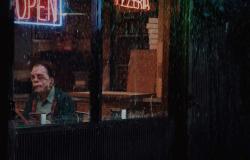Based on a news story, this thriller by Marc Evans brilliantly depicts the social and psychological collapse of Great Britain in the 1970s. Steeltown Murdersto be seen this Thursday October 3 at 8:55 p.m. on Arte and available Arte.TV.
South Wales, 1973. Three murders were committed in the space of three months in Neath Port Talbot. Three young girls, including two friends, each of them carrying traces of seminal fluid, all dead from strangulation. And no police officer capable of establishing a link between the cases allowing the search for a serial killer to be officially confirmed. Except Paul Bethel, a young, intuitive and ambitious inspector, perhaps too much in the eyes of his superiors.
It was not until 2002, the appointment as head of the PJ of a woman keen to bring justice to dozens of victims of unresolved cases – too often women -, the emergence of analyzes and cross-checking of DNA and the insistence of Bethel, although he was close to retirement, to reopen the investigation.
Intimate excesses
A “cold case” as only the English know how to tell them. Built over two eras, this series inspired by real events takes up step by step the stages of a very sad investigation while brilliantly depicting its social, intimate and historical context. On the one hand, there are internal struggles within the police, where the younger generation is greeted with the greatest suspicion by a petty-bourgeois and conservative rearguard. On the other, a working population consumed by the fear of factory closures and its growing anger against the bosses, the system, and the untimely government measures taken from London.
Some English critics are beginning to get annoyed by the psycho-political-historical-social thriller equation and the use, as a backdrop, of the providential windfall that constitutes the successive economic crises of England in the 1970s and 1980s. They are, whatever one thinks, at the origin of so many dramas and excesses of the intimate that it seems difficult to ignore them.
Here frustrated cops, a killer whose intentions and their origin we gradually understand, but also destitute families facing a sort of generalized incompetence, deprived of their child, the culprit and this door – that of justice – supposed to open the way to mourning. People destroyed. Exactly like the parents of Geraldine Hughes, Pauline Floyd and Sandra Newton, the infamous victims of Joseph Kappen, whom the British press nicknamed the “Saturday Night Strangler” because he spotted his victims on Saturday evenings on the from the ferry pier which brought them from Swansea (the big city) to Britton Ferry.
Double temporality
Ed Whitmore, the screenwriter of Manhunt et Rillington Placefocuses on the unfinished criminal investigation with a modesty that honors the subject. Marc Evans, the director of the same Manhunt, Hinterland and the excellent Safe Housetakes care of the decor without ever falling into the pitfall of vintage decor; directs actors whose acting palette is captivating; manages the double temporality with the precision of a metronome and films England, more precisely Wales as it was in 1973 and as it is in 2002, between industrial wastelands, residential suburbs and port infrastructures, without show too much. If the four episodes unfold the edifying investigation, they also compose a remarkable human fresco.






